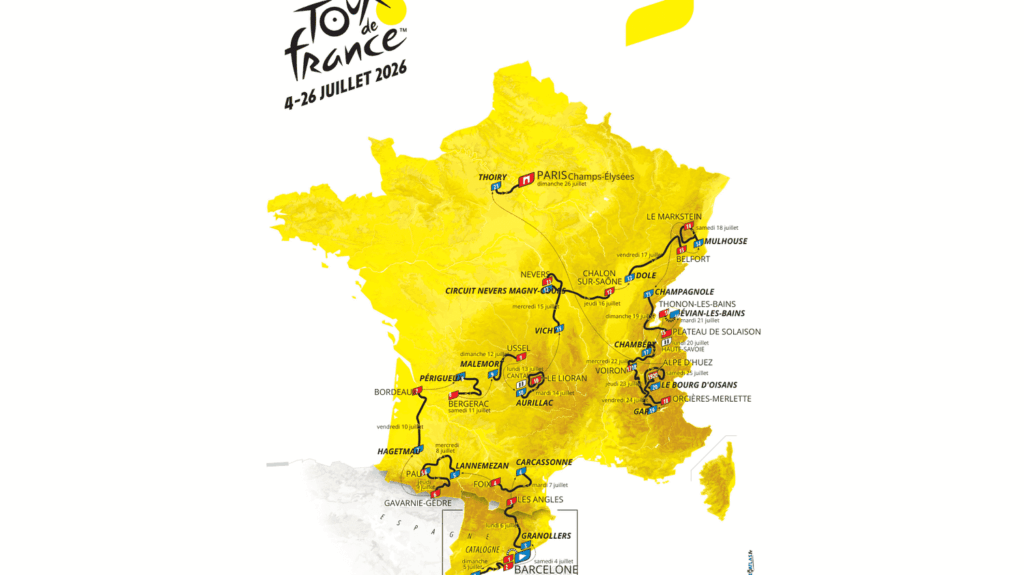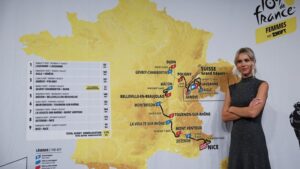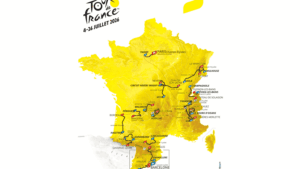
The organizers of the Grande Boucle unveiled on Thursday the route for the 113th edition, which will start from Barcelona, Spain, on July 4.
/2024/03/22/logosport1-65fdc209c3726464026706.png)
Published
Updated
Reading time: 5min
/2025/10/22/copie-de-xs-68f938682d7c0275909096.png)
The route of the Tour de France 2026 is now known. The organizer of the event revealed, Thursday October 23, the details of the 21 stages which will make up the route of the next edition of the Grande Boucle. After a 100% French route in 2025, the Tour de France returns to a start abroad, in Barcelona, Spain. The race will be launched around the Catalan city with an inaugural team time trial, a first in 55 years.
After the first three days in Spain, the peloton will return to French roads and attack the Pyrenees, with a first arrival at unprecedented altitude in Gavarnie-Gèdre, during the 6th stage. The race will then go up diagonally towards the Alps, with a crossing of the Massif Central, and a detour via the Vosges and the Jura. In total, the runners will cover 3,333 kilometers in three weeks of racing.
The Pyrenees early, the Alps in conclusion: a route in the form of a rise in power
With a Grand Départ from Spain, the Pyrenees were quickly expected on the program. They will welcome the peloton from the evening of the 3rd stage, in the Angles station, before a first arrival at the summit in Gavarnie-Gèdre, a unique stage town, on the 6th stage, after having crossed the Col d'Aspin and the Tourmalet (17.1 km at 7.3%). “The mountains arrive quickly, but we made sure not to get too hard during the three days we spent in the Pyrenees”reveals the director of the event Christian Prudhomme.
The route then provides for a challenging passage through the Massif Central, with the 10th stage heading towards Lioran, where Jonas Vingegaard won in the sprint against Tadej Pogacar in 2024, and where the peloton will pass through the Col de la Griffoul for the first time. The Grande Boucle will also cross the Vosges, with the Grand Ballon and an arrival at Markstein during the 14th stage, the day after the longest day of racing (205 km between Dole and Belfort).
Finally, the peloton will reach the Alps for an explosive final week. With an individual time trial between Evian-les-Bains and Thonon-les-Bains (16th stage) of 26 kilometers, a “explosive cocktail” d’“one third up, one third down, one third flat” according to Christian Prudhomme, and three of the five altitude arrivals planned in this edition.
Double arrival at Alpe d'Huez just before returning to Paris
There will be one final huge piece before we see the arrival in Paris. After 18 days of fighting, the peloton will tackle a pair of stages at Alpe d'Huez, a legendary finish in the history of the Tour. The first day, during the 19th stage, will see the runners tackle the 21 bends to the station, after 128 kilometers of racing.
The second, the next day, will be the queen stage of the edition, with 5,600 meters of positive altitude difference and the sequence of the passes of the Croix de Fer (24 km at 5.2%), Télégraphe (11.9 km at 7.1%) and Galibier (17.7 km at 6.9%), before an unprecedented ascent via the Col de Sarenne (12.3 km at 7.3%), taken only once in 2013 in the direction of descent. “So much elevation gain on the eve of the Champs-Elysées is unheard of”assures Christian Prudhomme.
/2025/10/22/alpe-2-68f91091db0c1734867763.png)
With an arrival at Alpe d'Huez on the eve of the last stage, a long transfer will also be expected for the entire peloton in order to reach Île-de-France and the departure town, Thoiry (Yvelines), for the finale of this 113th edition.
The Butte Montmartre again on the menu for the last stage
As during the Paris 2024 Olympic Games, and as during the 2025 edition, the last stage of the Tour de France will pass through the Butte Montmartre and Rue Lepic, in a classic-shaped section of the route. A popular success of the Olympics, the loop north of Paris was added to the route of the last Tour a few weeks before the start, and was the scene of a warm atmosphere among the public.
The peloton will climb the Montmartre hill three times, where Wout van Aert made the difference to win the last stage this summer, before returning towards the Champs-Elysées from the North and the Place de l'Etoile, enough to complete an almost complete tour. And give the strongest sprinters still in the race a chance to win a prestigious victory.





